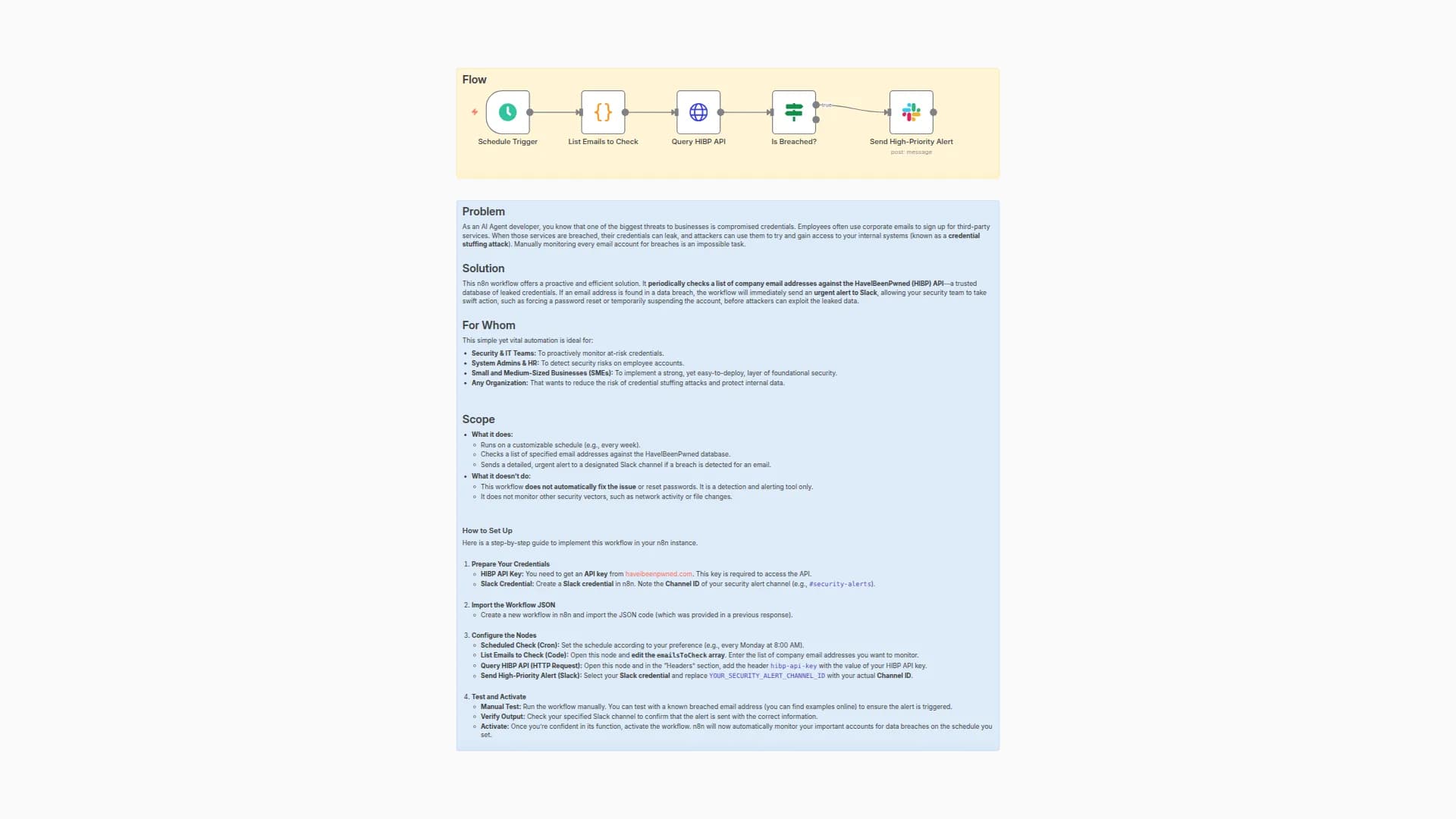Monitor Data Breaches in Real-time with Have I Been Pwned
Last edited 151 days ago
Who is this for?
- Security professionals
- Developers
- Individuals interested in data breach awareness
Use Case
- Automated monitoring for new breaches
- Proactive identity protection
- Demonstration of simple cache mechanism
What this workflow does
- Checks the Have I Been Pwned API every 15 minutes for the latest breaches.
- Compares new breach data against previously notified breaches.
- Demonstrates a simple cache mechanism to track previously seen breaches.
How the Cache Functionality Works
- Read from Cache: Retrieves the last known breach from
cache.jsonto avoid redundant alerts for the same breach. - Compare Against Current Breach: The workflow checks if the latest fetched breach differs from the cached one.
- Update the Cache: If a new breach is detected, it updates
cache.jsonwith the latest breach data.
Setup instructions
- The endpoint used in this workflow does not require an API key.
- Add your desired alert mechanism in the red box attached to the
New breachnode.
How to customize this workflow to your needs
- Modify Notification Settings: Tailor where alerts are sent (email, Slack, etc.). Add the desired node after the
New breachnode. This node contains all the data from the breach so it is eaisily available. You can choose from a variety of n8n nodes to send alerts when a new breach is detected. Below are a few common options you might consider adding after the New breach node:
- Email Node What it does: Sends an email notification to one or more recipients. Use case: Great for simple alerts to your inbox or a team distribution list. Customization: You can include breach details in the subject or body of the email, using data from the New breach node.
- Slack Node What it does: Sends a message to a Slack channel or user. Use case: Perfect for real-time alerts to your team in Slack. Customization: You can post breach details directly in a channel or DM. You can also format the message (bold, code blocks, etc.).
- Microsoft Teams Node What it does: Sends a message to a Teams channel. Use case: For organizations that use Microsoft Teams for communication. Customization: Similar to Slack, you can customize the message content and include all relevant breach information.
- Discord Node What it does: Sends an alert message to a Discord channel. Use case: Useful for teams or communities that coordinate via Discord. Customization: Add formatted messages with breach details for easy viewing.
- Telegram Node What it does: Sends messages to a Telegram chat or group. Use case: Good for mobile notifications and fast alerts. Customization: You can include breach summaries or detailed information, and even use bots to automate this.
- Webhook Node (as a sender) What it does: Sends breach data to another service via a webhook. Use case: If you have an external system or app that handles alerts, you can push the data directly to it. Customization: Send JSON payloads with detailed breach information to trigger actions in other systems.
- SMS Nodes (like Twilio) What it does: Sends an SMS notification to one or more phone numbers. Use case: For urgent alerts that need to be seen immediately. Customization: Keep messages concise, including key breach details like the time, type of breach, and affected system.
- Adjust Check Frequency: Change the interval in the Schedule Trigger node (e.g., hourly or daily).
You may also like
New to n8n?
Need help building new n8n workflows? Process automation for you or your company will save you time and money, and it's completely free!





